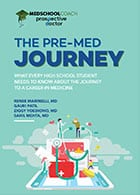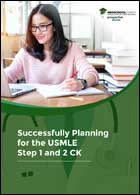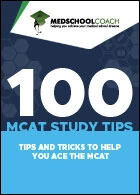
Embarking on real-world clinical rotations can be daunting. Join Dr. Jeanie Gribben, the Associate Director of Medical School Tutoring at MedSchoolCoach, as she, along with Dr. Daniel Veyg and Dr. Hanna Vinitsky, share invaluable insights.
Discover the art of transitioning from the classroom to clinical practice, mastering patient care, effective team collaboration, confident communication, and strategies to navigate the pressures of clinical rotations.
Embarking on clinical rotations is a significant milestone in a medical student’s journey. It’s the bridge between classroom learning and real-world clinical practice, offering students a chance to apply their knowledge, hone their skills, and truly make a difference in patients’ lives. However, the transition can be daunting.
Fortunately, Dr. Jeanie Gribben, the Associate Director of Medical School Tutoring at MedSchoolCoach, recently hosted a webinar to guide students through this pivotal phase. Alongside her were MedSchoolCoach Master Tutors, Dr. Daniel Veyg and Dr. Hanna Vinitsky, who shared their wisdom and experiences.
Here are some of the key takeaways from the session.
1. Embrace the Shift from Theory to Practice
Clinical rotations mark a significant transition in a medical student’s journey. Unlike the structured environment of classrooms where learning is primarily theoretical, clinical rotations plunge students into the dynamic world of real-life medical practice. Here’s a deeper dive into this transition based on the insights from the webinar:
Practical Skills Over Theoretical Knowledge: While the knowledge acquired in classrooms lays the foundation, clinical rotations demand a hands-on approach. This means performing actual procedures, diagnosing real patients, and making critical decisions on the spot.
Patient Interaction is Key: One of the primary focuses of the webinar led by Dr. Jeanie Gribben was the importance of patient interaction. Building a rapport with patients, understanding their concerns, and communicating effectively are skills that every medical student must master. It’s not just about treating a disease; it’s about treating the individual.
Learning on the Job: The real-world clinical environment is unpredictable. Students will encounter situations that weren’t covered in textbooks. Being adaptable, asking questions when in doubt, and learning from each experience are crucial aspects of this phase.
Mentorship Matters: As highlighted in the webinar, interactions with mentors, peers, and other healthcare professionals play a pivotal role in a student’s growth. They provide invaluable feedback, share their experiences, and guide students in applying their theoretical knowledge effectively.
2. Prioritize Outstanding Patient Care
Patient care is the heart and soul of the medical profession. During clinical rotations, it becomes the primary metric by which a medical student’s performance is evaluated. Here’s a more detailed exploration of prioritizing outstanding patient care:
Holistic Approach: Outstanding patient care is not just about addressing the medical issue at hand. It’s about understanding the patient as a whole – their fears, concerns, lifestyle, and even their family dynamics. This holistic approach ensures that the treatment plan is tailored to the individual, leading to better outcomes.
Effective Communication: As highlighted in the webinar, communication is a cornerstone of patient care. It’s not just about conveying medical information but doing so in a manner that’s empathetic and easily understandable. This builds trust and ensures that patients are more likely to adhere to treatment plans.
Teamwork: The webinar emphasized the importance of working effectively in a team. In a clinical setting, patient care is a collaborative effort, involving nurses, specialists, and other healthcare professionals. By fostering good relationships with colleagues and ensuring seamless communication, patient care can be optimized.
Continuous Learning: The medical field is ever-evolving. To provide the best patient care, it’s essential to stay updated with the latest research, techniques, and best practices. This commitment to continuous learning ensures that patients receive the most current and effective treatments.
Ethical Considerations: Outstanding patient care also means upholding the highest ethical standards. This includes respecting patient confidentiality, being honest about diagnoses and treatment options, and always acting in the best interest of the patient.
In essence, to excel during clinical rotations, medical students must view patient care not just as a duty, but as a privilege. By being attentive, compassionate, and thorough, they can make a meaningful difference in the lives of those they serve.
3. Collaborate Effectively with Your Team
The clinical setting is a complex ecosystem where various professionals come together with a shared goal: ensuring the best possible care for patients. Delving deeper into this topic:
Understanding Roles: Each member of the healthcare team, from nurses to specialists, plays a unique and crucial role. Recognizing and respecting these roles is the first step towards effective collaboration. For instance, nurses often have a closer day-to-day interaction with patients and can provide valuable insights into their condition and needs.
Open Communication: As emphasized in the webinar, clear and open communication is paramount. This means actively listening to team members, sharing your observations, and ensuring that everyone is on the same page regarding treatment plans and patient status.
Learning from Seniors: Senior doctors and experienced healthcare professionals are a treasure trove of knowledge and experience. Engaging with them, seeking their advice, and learning from their experiences can greatly enhance a student’s clinical acumen and decision-making skills.
Feedback is a Gift: In a collaborative environment, feedback is inevitable. Instead of viewing it defensively, see it as an opportunity for growth. Constructive criticism from peers and seniors can help identify areas of improvement and enhance one’s skills.
Conflict Resolution: Differences in opinions and approaches are natural in a team setting. However, it’s essential to address conflicts professionally and constructively. Prioritizing patient care above personal egos and finding common ground can lead to better outcomes and a harmonious work environment.
Shared Responsibility: In the clinical setting, successes and failures are often collective. Embracing a sense of shared responsibility ensures that everyone works towards a common goal and supports each other during challenging times.
The clinical environment thrives on teamwork. By collaborating effectively, medical students not only enhance the quality of patient care but also enrich their learning experience and establish themselves as indispensable members of the healthcare team.
Related Resource: Beyond Shadowing — A Virtual Clinical Education
4. Communicate with Confidence
Effective communication is a cornerstone of medical practice, and its importance was underscored. Beyond the basic tenets of clarity and confidence, there are several nuances to consider when communicating in a clinical setting. Let’s delve deeper into this topic:
Tailored Communication: Different audiences require different communication styles. For instance, when speaking to patients, it’s essential to use layman’s terms and avoid medical jargon. On the other hand, discussions with peers or mentors might require a more technical approach, referencing specific medical terms and concepts.
Empathy is Essential: Especially when dealing with patients, it’s crucial to approach conversations with empathy. Understand their fears, concerns, and emotions. This not only builds trust but also ensures that patients feel heard and understood.
Body Language Matters: Communication isn’t just verbal. Non-verbal cues, such as maintaining eye contact, having an open posture, and nodding in understanding, can convey confidence and attentiveness.
Active Listening: As highlighted in the webinar, active listening is a vital component of effective communication. This means fully concentrating on what’s being said, understanding the information, and responding thoughtfully. It’s about being present in the conversation and showing genuine interest.
Seek Clarification: If something is unclear, whether it’s a patient’s symptom description or a mentor’s instruction, don’t hesitate to ask for clarification. It’s better to seek understanding at the outset than to make assumptions that could lead to errors.
Feedback and Reflection: After interactions, especially challenging ones, take a moment to reflect. Consider what went well and what could be improved. This self-awareness and willingness to adapt are crucial for continuous growth in communication skills.
Maintain Professional Boundaries: While it’s essential to be empathetic and understanding, it’s equally important to maintain professional boundaries. This ensures that interactions remain respectful and focused on the task at hand.
Confident communication is more than just speaking clearly; it’s about understanding, empathy, and adaptability. By mastering these skills, medical students can ensure effective interactions with patients, mentors, and peers, enhancing both their clinical practice and learning experience.
5. Master Time Management
The demands of clinical rotations are multifaceted, making time management an indispensable skill for medical students. The webinar touched upon the importance of effectively managing time during high-pressure clinical rotations. Expanding on this crucial topic:
Plan Ahead: Begin each day or week with a clear plan. This might involve reviewing patient lists, understanding scheduled procedures, or preparing for rounds. Having a roadmap helps in allocating time efficiently and anticipating potential challenges.
Prioritize Tasks: Not all tasks hold equal importance. Learn to differentiate between urgent and important tasks. For instance, attending to a critically ill patient takes precedence over routine paperwork.
Break Tasks into Manageable Chunks: Large tasks can be overwhelming. Breaking them down into smaller, more manageable tasks can make them less daunting and more achievable. This approach also allows for a sense of accomplishment as each segment is completed.
Avoid Procrastination: In the high-paced world of clinical rotations, delaying tasks can lead to a snowball effect, where responsibilities pile up. Address tasks promptly, especially those that are time-sensitive.
Utilize Downtime: There might be moments of downtime, such as waiting for lab results or between patient consultations. Use these intervals wisely, perhaps for quick revisions, updating patient records, or even self-care.
Seek Mentorship: Senior doctors and experienced peers can offer valuable insights into time management strategies that have worked for them. Their experiences can provide practical tips and shortcuts that can be immensely beneficial.
Stay Organized: Keeping organized notes, maintaining updated patient records, and using digital tools or apps can streamline tasks and save time. An organized approach reduces the chances of overlooking important details.
Set Realistic Expectations: While it’s essential to be proactive and efficient, it’s equally important to recognize one’s limits. Overextending can lead to burnout. It’s okay to seek help or delegate tasks when necessary.
Reflect and Adjust: At the end of each day or week, reflect on what went well and what didn’t in terms of time management. Continuous self-assessment and adjustment of strategies can lead to improved efficiency over time.
Mastering time management during clinical rotations is not just about getting tasks done but doing so in a manner that ensures quality care, continuous learning, and personal well-being. With the right strategies and a proactive approach, medical students can navigate the demands of clinical rotations with confidence and competence.
6. Seek Feedback and Continuously Improve
Feedback is an invaluable resource in the medical profession, offering insights into one’s strengths and areas of improvement. The webinar emphasized the significance of being receptive to feedback during clinical rotations. Delving deeper into this aspect:
Embrace a Growth Mindset: Understand that feedback is not a critique of your worth but a tool to help you grow. By adopting a growth mindset, you’ll view feedback as an opportunity to learn and evolve, rather than as criticism.
Actively Solicit Feedback: Don’t wait for feedback to come your way. Proactively seek it out. After a procedure or patient interaction, ask mentors or peers for their observations and suggestions. This shows initiative and a genuine desire to improve.
Listen Actively: When receiving feedback, listen attentively without interrupting or becoming defensive. Understand the perspective of the person providing the feedback and ask clarifying questions if something is unclear.
Reflect on Feedback: After receiving feedback, take some time to reflect on it. Consider its validity, how it aligns with your self-assessment, and how you can implement the suggested changes.
Document and Track: Maintain a feedback journal or digital record. Documenting feedback allows you to track your progress over time, identify recurring themes, and set specific improvement goals.
Engage in Peer Review: Engaging in peer review sessions, where you and your peers assess each other’s performance, can offer diverse perspectives and insights that might not be apparent to you.
Implement Changes: Feedback is only as valuable as the changes it inspires. Act on the feedback you receive. Whether it’s adjusting your approach to patient care, refining a technical skill, or improving communication, take tangible steps towards improvement.
Thank Patients for Their Feedback: Patients offer a unique perspective, and their feedback can be instrumental in improving patient care. If a patient offers feedback, thank them for their input and assure them that their insights are valued.
Continuous Learning: Pair feedback with continuous learning. Attend workshops, seminars, and training sessions to address areas of improvement and stay updated with the latest best practices.
In essence, feedback is a mirror that reflects both strengths and areas of growth. By seeking feedback and continuously striving to improve, medical students can ensure that they are always progressing in their journey, delivering the best possible care, and growing as professionals.
7. Stay Curious and Keep Learning
The realm of medicine is characterized by constant advancements and discoveries. As emphasized in the webinar, maintaining an insatiable curiosity is pivotal for any medical professional. Here’s a deeper exploration of this principle:
- Network with Peers and Experts: Building relationships with fellow medical professionals can provide insights into new research, techniques, and methodologies. Sharing experiences and knowledge can lead to collaborative learning.
Utilize Digital Resources: With the rise of technology, there are numerous online platforms, journals, and databases available. Regularly accessing these resources can provide insights into the latest research and medical breakthroughs.
Participate in Research: If possible, get involved in medical research. This not only contributes to the broader medical community but also ensures that you’re at the forefront of new discoveries and innovations.
In essence, the journey of a medical professional is one of perpetual learning. By staying curious and actively seeking knowledge, medical students can ensure they remain at the pinnacle of their profession, offering the best care to their patients.
Partnering with MedSchoolCoach
MedSchoolCoach is your ultimate companion when it comes to acing shelf exams and the USMLE Step 2. Understanding the intricacies of these exams can be challenging, but with MedSchoolCoach by your side, you’re equipped with personalized strategies and expert guidance.
With experienced tutors like Dr. Jeanie Gribben on board, MedSchoolCoach provides tailored tutoring sessions specifically aimed at mastering the content and strategies needed for shelf exams and the USMLE Step 2. Their comprehensive approach goes beyond the textbooks, ensuring you not only understand the material but also know how to apply it in a test scenario.
Whether you’re struggling with a particular subject area or looking for techniques to boost your test-taking confidence, MedSchoolCoach has the expertise and resources to support you. So, for a holistic approach to mastering the USMLE Step 2 and shelf exams, turn to MedSchoolCoach. They’re dedicated to your success, every step of the way.





